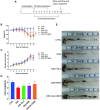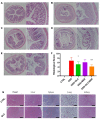Macrophage-Targeted Berberine-Loaded β-Glucan Nanoparticles Enhance the Treatment of Ulcerative Colitis
- PMID: 36406639
- PMCID: PMC9673505
- DOI: 10.2147/IJN.S379792
Macrophage-Targeted Berberine-Loaded β-Glucan Nanoparticles Enhance the Treatment of Ulcerative Colitis
Abstract
Aim: This study focuses on constructing of an anti-inflammatory drug delivery system by encapsulation of berberine in the β-glucan nanoparticles and evaluates its effect on treating ulcerative colitis.
Methods: β-Glucan and the anti-inflammatory drug berberine (BER) are self-assembled into nanoparticles to construct a drug delivery system (GLC/BER). The interaction between the drug and the carrier was characterized by circular dichroism, ultraviolet-visible spectroscopy, and dynamic light scattering. The anti-inflammatory effect of the GLC/BER was evaluated through a lipopolysaccharide (LPS)-induced RAW264.7 macrophage inflammation model and a sodium sulfate (DSS)-induced C57BL/6 mouse ulcerative colitis model.
Results: The GLC/BER nanoparticles have a particle size of 80-120 nm and a high encapsulation efficiency of 37.8±4.21%. In the LPS-induced RAW264.7 macrophage inflammation model, GLC/BER significantly promoted the uptake of BER by RAW264.7 cells. RT-PCR and ELISA assay showed that it could significantly inhibit the inflammatory factors including IL-1β, IL-6 and COX-2. Furthermore, GLC/BER shows inhibiting effect on the secretion of pro-inflammatory factors such as IL-1β and IL-6, down-regulating the production of nitrite oxide; in animal studies, GLC/BER was found to exert a relieving effect on mice colitis.
Conclusion: The study found that GLC/BER has an anti-inflammatory effect in vitro and in vivo, and the GLC carrier improves the potency and bioavailability of BER, providing a new type of nanomedicine for the treatment of colitis.
Keywords: anti-inflammation; chiral; drug carrier; immunoregulation; β-glucan.
© 2022 Xu et al.
Conflict of interest statement
The authors report no conflicts of interest in this work.
Figures







Similar articles
-
Berberine-loaded PLGA nanoparticles alleviate ulcerative colitis by targeting IL-6/IL-6R axis.J Transl Med. 2024 Oct 24;22(1):963. doi: 10.1186/s12967-024-05682-x. J Transl Med. 2024. PMID: 39448992 Free PMC article.
-
[Experimental study on effects of berberine combined with 6-shogaol on intestinal inflammation and flora in mice with ulcerative colitis].Zhongguo Zhong Yao Za Zhi. 2022 Aug;47(16):4418-4427. doi: 10.19540/j.cnki.cjcmm.20220413.401. Zhongguo Zhong Yao Za Zhi. 2022. PMID: 36046871 Chinese.
-
Protective effects of berberine hydrochloride on DSS-induced ulcerative colitis in rats.Int Immunopharmacol. 2019 Mar;68:242-251. doi: 10.1016/j.intimp.2018.12.036. Epub 2019 Feb 8. Int Immunopharmacol. 2019. PMID: 30743078
-
[Therapeutic effect of ursodeoxycholic acid-berberine supramolecular nanoparticles on ulcerative colitis based on supramolecular system induced by weak bond].Zhongguo Zhong Yao Za Zhi. 2023 May;48(10):2739-2748. doi: 10.19540/j.cnki.cjcmm.20230223.301. Zhongguo Zhong Yao Za Zhi. 2023. PMID: 37282934 Chinese.
-
Therapeutic potential and underlying mechanisms of phytoconstituents: emphasizing on resveratol, curcumin, quercetin, berberine, and hesperidin in ulcerative colitis.Naunyn Schmiedebergs Arch Pharmacol. 2025 Jun;398(6):6579-6596. doi: 10.1007/s00210-025-03811-x. Epub 2025 Jan 29. Naunyn Schmiedebergs Arch Pharmacol. 2025. PMID: 39878817 Review.
Cited by
-
Berberine-loaded PLGA nanoparticles alleviate ulcerative colitis by targeting IL-6/IL-6R axis.J Transl Med. 2024 Oct 24;22(1):963. doi: 10.1186/s12967-024-05682-x. J Transl Med. 2024. PMID: 39448992 Free PMC article.
-
Can Nature Overcome Invasive Gastrointestinal Infections?Int J Mol Sci. 2025 Jun 17;26(12):5795. doi: 10.3390/ijms26125795. Int J Mol Sci. 2025. PMID: 40565258 Free PMC article. Review.
-
Exploration of Berberine Against Ulcerative Colitis via TLR4/NF-κB/HIF-1α Pathway by Bioinformatics and Experimental Validation.Drug Des Devel Ther. 2024 Jul 9;18:2847-2868. doi: 10.2147/DDDT.S436359. eCollection 2024. Drug Des Devel Ther. 2024. PMID: 39006190 Free PMC article.
References
-
- Friedrich MJ. Inflammatory bowel disease goes global. JAMA. 2018;319(7):648. - PubMed
-
- Bitzer ZT, Elias RJ, Vijay-Kumar M, Lambert JD. (-)-Epigallocatechin-3-gallate decreases colonic inflammation and permeability in a mouse model of colitis, but reduces macronutrient digestion and exacerbates weight loss. Mol Nutr Food Res. 2016;60(10):2267–2274. doi:10.1002/mnfr.201501042 - DOI - PubMed
MeSH terms
Substances
LinkOut - more resources
Full Text Sources
Medical
Research Materials

